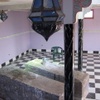Disclaimer
This entry contains information known to us from a variety of sources but may not include all the information currently available. Please be in touch if you notice any inadvertent mistakes in our presentation or have additional knowledge or sources to share. Thank you.
Archive
Cemetery at Ouarzazate, Morocco
In a city whose name means “without noise”, the cemetery of Ouarzazate also sits silently. Surrounded by a high mud wall capped with a barbed-wire crown, the Jewish cemetery of Ouarzazate appears mostly to be an earthen field, with clumps of stones and a few concrete slabs marking old graves. Outside the walls are film studios where Hollywood classics like Star Wars have been shot. Inside the cemetery, the only “blockbuster” is an elegant shrine with black marble columns protecting the 400-year-old graves of two rabbis.
Description
City: Known as the “gateway to the Sahara,” Ouarzazate is an old trading depot, located strategically at the crossroads of three regions: the Atlas Mountains to the north, the Dra’a Valley to the east, and the Dades Valley to the south. In the 20th Century, the French turned the town into an administrative center for the region and Ouarzazate swelled in size. Today, over 50,000 people live in the city, which is now known as the “Hollywood of Morocco” for the many film studios just outside the downtown. “Lawrence of Arabia” and “Gladiator” among other Hollywood hits have been filmed in town.
Jewish Community: In the 17th Century, the local ruler built a kasbah known as Taourirt (“Hill” in Tamazigh, the Amazigh (Berber) language), and Jews soon established a mellah just outside the palace. Many were merchants, peddlers, and jewelers. The original location of the mellah is believed to be within a few yards of the kasbah, but, according to oral history, one of the quarter’’s walls collapsed and a new mellah was built about 100 yards away. Almost no ruins of the old mellah remain. In 1954, 170 Jews lived in the mellah. Almost all had left by the 1960s, though one Jewish peddler of animal skins remained, living above the synagogue until he grew old. Today that synagogue is a carpet store, producing and selling Ouarzazate’s distinctive woven carpets.
Cemetery: The high wall surrounding the cemetery appears to be a relative new construction. Remnants of women’s clothing atop some of the graves indicate that local Muslims often accessed the cemetery for fertility rituals (a common belief holds that a woman who wants to become pregnant should wash herself on a Jewish grave). Due to vandalism and to wear from the elements, no graves are fully intact and most are simply piles of rubble. A few small gravestones fragments with Hebrew writing are the only obvious markers of the cemetery’s inhabitants.
Ouarzazate Jewish Cemetery (Morocco)
Shrine: The one well-maintained section of the cemetery is a 200 square foot pinkish building with a copula that protects the graves of two rabbis. Writing on their gravestones has worn away, but one is apparently named Ait Hemyas and both appear to have lived about 400 years ago. Black marble columns support the roof and intricate lamps light the hall, which is also lit by a skylight. The structure was apparently built by a former resident of the city named Meir Ben Barukh. He has hired a caretaker, who has a register of some of the individuals buried in the cemetery. The guardian’s phone number is painted on the metal gate to the cemetery.
Sources
Aomar Boum. "Ouarzazate (and region)." Encyclopedia of Jews in the Islamic World. Executive Editor Norman A. Stillman. Brill Online, 2014. Reference. Wellesley College. 14 July 2014 <http://referenceworks.brillonline.com/entries/encyclopedia-of-jews-in-the-islamic-world/ouarzazate-and-region-SIM_0017140>.
DiarnaInfo. "Ouarzazate Jewish Cemetery (Morocco)." Online video clip. Youtube. Youtube, 28 June 2010. Web. 11 July 2014. <https://www.youtube.com/watch?v=yqG4osdOrm4>.
![Ourzazate Cemetery, Shrine, Gate [3] (Ourzazate, Morocco, 2010)](https://cdn.filestackcontent.com/5ej7uTKQQV27bp015Rfk/convert?w=100&h=100&fit=crop)
![Ourzazate Cemetery, Shrine, Gate [2] (Ourzazate, Morocco, 2010)](https://cdn.filestackcontent.com/qkfGhzS4TPypVbLU368i/convert?w=100&h=100&fit=crop)
![Ourzazate Cemetery, Shrine, Interior [3] (Ourzazate, Morocco, 2010)](https://cdn.filestackcontent.com/YYcoqzQq65dCQhR6BjA8/convert?w=100&h=100&fit=crop)


![Ourzazate Cemetery, Shrine, Exterior [2] (Ourzazate, Morocco, 2010)](https://cdn.filestackcontent.com/8DpUrINoTKCbKIAQwfNJ/convert?w=100&h=100&fit=crop)


![Ourzazate Cemetery, Shrine, Interior [2] (Ourzazate, Morocco, 2010)](https://cdn.filestackcontent.com/UPHNMZiQ9eEt39ooLaXT/convert?w=100&h=100&fit=crop)
![Ourzazate Cemetery, Shrine, Interior [1] (Ourzazate, Morocco, 2010)](https://cdn.filestackcontent.com/18EkazMTdZ9r9KtoIAeP/convert?w=100&h=100&fit=crop)
![Ourzazate Cemetery, Yard [2] (Ourzazate, Morocco, 2010)](https://cdn.filestackcontent.com/Dt5nVVxfTNioV3C5umXR/convert?w=100&h=100&fit=crop)
![Ourzazate Cemetery, Grave [5] (Ourzazate, Morocco, 2010)](https://cdn.filestackcontent.com/euPzy4GCQiebvNeLl3L7/convert?w=100&h=100&fit=crop)
![Ourzazate Cemetery, Yard [1] (Ourzazate, Morocco, 2010)](https://cdn.filestackcontent.com/9N8XRV8xTdGcpxx3ty7Q/convert?w=100&h=100&fit=crop)
![Ourzazate Cemetery, Grave [4] (Ourzazate, Morocco, 2010)](https://cdn.filestackcontent.com/vaOFBoH7SnKsmr8wKA0x/convert?w=100&h=100&fit=crop)
![Ourzazate Cemetery, Grave [3] (Ourzazate, Morocco, 2010)](https://cdn.filestackcontent.com/sNtF1OhQGGwU1yo9MBy0/convert?w=100&h=100&fit=crop)

![Ourzazate Cemetery, Grave [2] (Ourzazate, Morocco, 2010)](https://cdn.filestackcontent.com/dLGp70CQNCBLmQPru6YA/convert?w=100&h=100&fit=crop)
![Ourzazate Cemetery, Grave [1] (Ourzazate, Morocco, 2010)](https://cdn.filestackcontent.com/ybJTx7RryViHSHbs0DwO/convert?w=100&h=100&fit=crop)
![Ourzazate Cemetery, Shrine, Exterior [1] (Ourzazate, Morocco, 2010)](https://cdn.filestackcontent.com/1J3RTVoPSLWyV3zxE3id/convert?w=100&h=100&fit=crop)
![Ourzazate Cemetery, Gate [1] (Ourzazate, Morocco, 2010)](https://cdn.filestackcontent.com/QRQkr379THuTtVzZoRhM/convert?w=100&h=100&fit=crop)